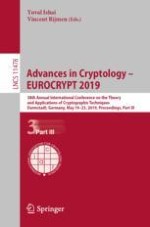2019 | OriginalPaper | Buchkapitel
Covert Security with Public Verifiability: Faster, Leaner, and Simpler
verfasst von : Cheng Hong, Jonathan Katz, Vladimir Kolesnikov, Wen-jie Lu, Xiao Wang
Erschienen in: Advances in Cryptology – EUROCRYPT 2019
Aktivieren Sie unsere intelligente Suche, um passende Fachinhalte oder Patente zu finden.
Wählen Sie Textabschnitte aus um mit Künstlicher Intelligenz passenden Patente zu finden. powered by
Markieren Sie Textabschnitte, um KI-gestützt weitere passende Inhalte zu finden. powered by

 commit to seeds, just like
commit to seeds, just like
 , and then use those seeds to generate the (pseudo)randomness to use in each instance. (This optimization is critical for realizing constant-size certificates.).
, and then use those seeds to generate the (pseudo)randomness to use in each instance. (This optimization is critical for realizing constant-size certificates.). runs in expected polynomial time; details are omitted for the sake of the exposition.
runs in expected polynomial time; details are omitted for the sake of the exposition.